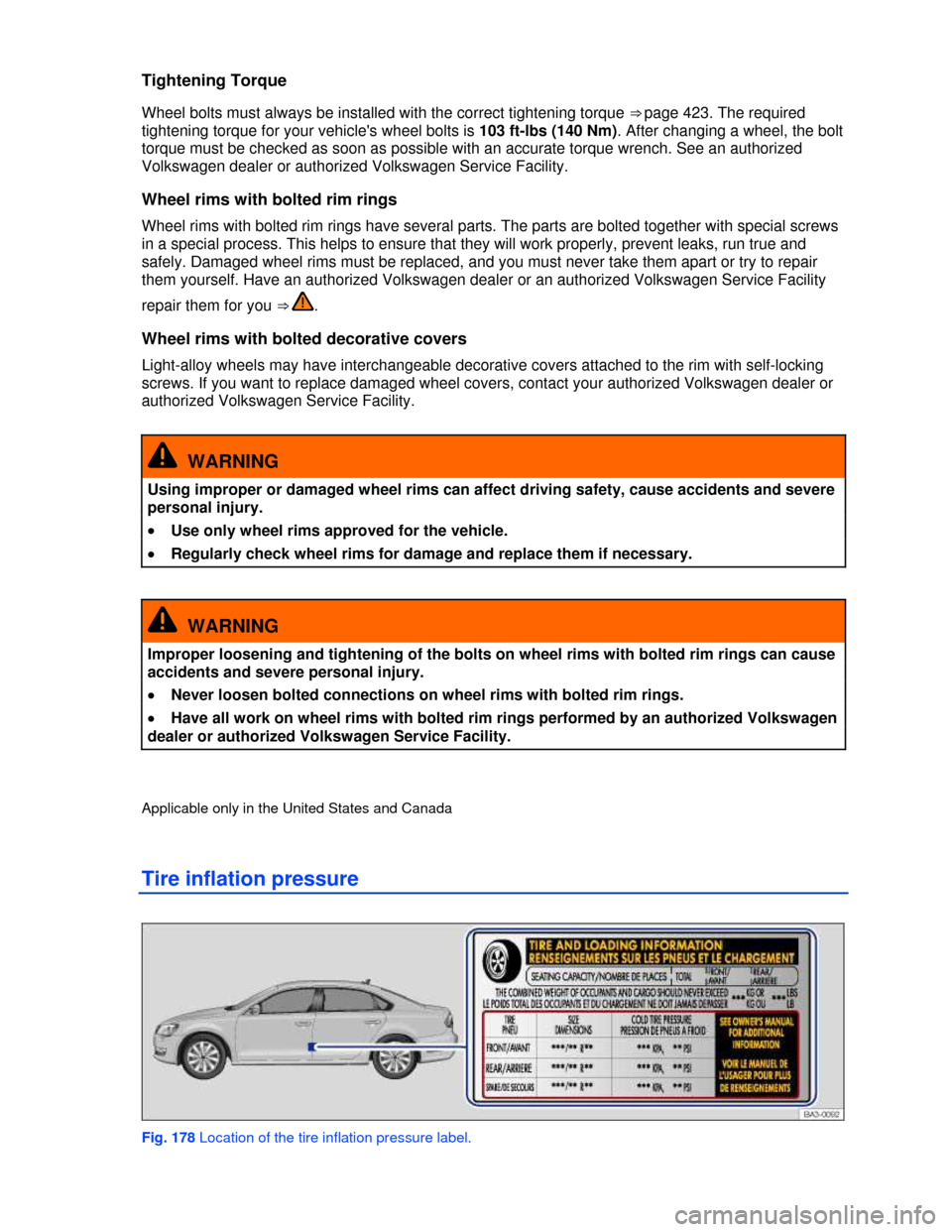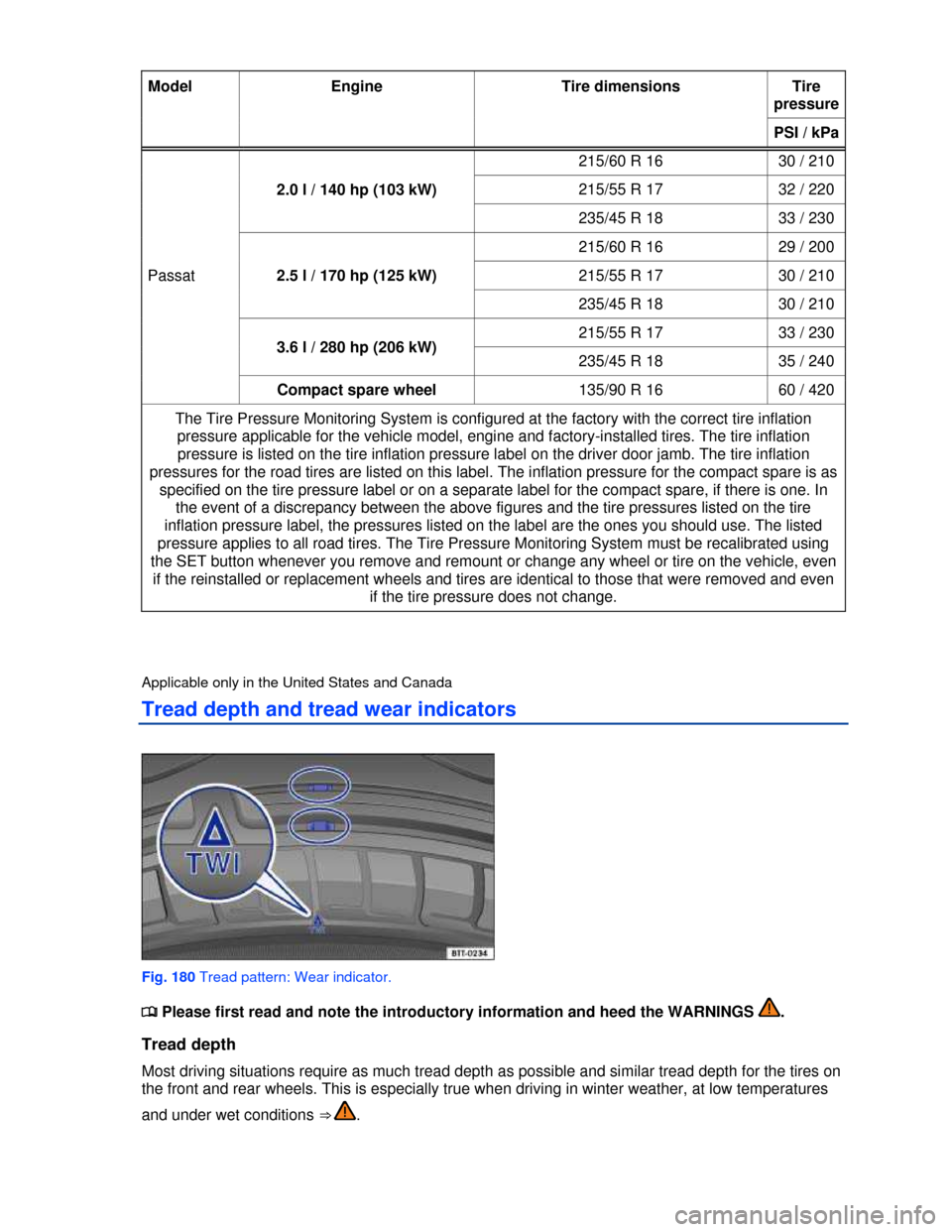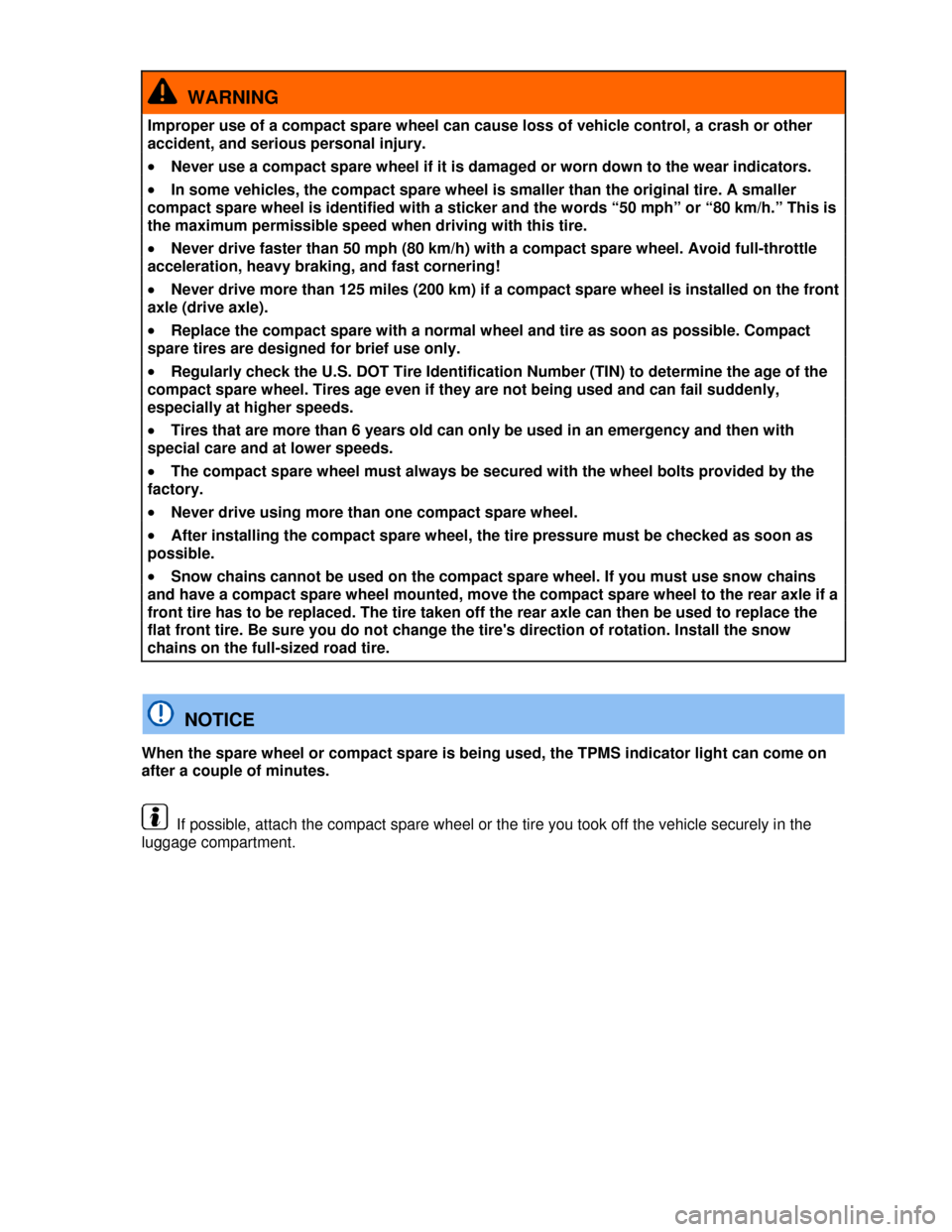2013 VOLKSWAGEN PASSAT change wheel
[x] Cancel search: change wheelPage 297 of 379

Tightening Torque
Wheel bolts must always be installed with the correct tightening torque ⇒ page 423. The required
tightening torque for your vehicle's wheel bolts is 103 ft-lbs (140 Nm). After changing a wheel, the bolt
torque must be checked as soon as possible with an accurate torque wrench. See an authorized
Volkswagen dealer or authorized Volkswagen Service Facility.
Wheel rims with bolted rim rings
Wheel rims with bolted rim rings have several parts. The parts are bolted together with special screws
in a special process. This helps to ensure that they will work properly, prevent leaks, run true and
safely. Damaged wheel rims must be replaced, and you must never take them apart or try to repair
them yourself. Have an authorized Volkswagen dealer or an authorized Volkswagen Service Facility
repair them for you ⇒ .
Wheel rims with bolted decorative covers
Light-alloy wheels may have interchangeable decorative covers attached to the rim with self-locking
screws. If you want to replace damaged wheel covers, contact your authorized Volkswagen dealer or
authorized Volkswagen Service Facility.
WARNING
Using improper or damaged wheel rims can affect driving safety, cause accidents and severe
personal injury.
�x Use only wheel rims approved for the vehicle.
�x Regularly check wheel rims for damage and replace them if necessary.
WARNING
Improper loosening and tightening of the bolts on wheel rims with bolted rim rings can cause
accidents and severe personal injury.
�x Never loosen bolted connections on wheel rims with bolted rim rings.
�x Have all work on wheel rims with bolted rim rings performed by an authorized Volkswagen
dealer or authorized Volkswagen Service Facility.
Applicable only in the United States and Canada
Tire inflation pressure
Fig. 178 Location of the tire inflation pressure label.
Page 299 of 379

Model Engine Tire dimensions Tire
pressure
PSI / kPa
Passat
2.0 l / 140 hp (103 kW)
215/60 R 16 30 / 210
215/55 R 17 32 / 220
235/45 R 18 33 / 230
2.5 l / 170 hp (125 kW)
215/60 R 16 29 / 200
215/55 R 17 30 / 210
235/45 R 18 30 / 210
3.6 l / 280 hp (206 kW) 215/55 R 17 33 / 230
235/45 R 18 35 / 240
Compact spare wheel135/90 R 16 60 / 420
The Tire Pressure Monitoring System is configured at the factory with the correct tire inflation
pressure applicable for the vehicle model, engine and factory-installed tires. The tire inflation
pressure is listed on the tire inflation pressure label on the driver door jamb. The tire inflation
pressures for the road tires are listed on this label. The inflation pressure for the compact spare is as
specified on the tire pressure label or on a separate label for the compact spare, if there is one. In
the event of a discrepancy between the above figures and the tire pressures listed on the tire
inflation pressure label, the pressures listed on the label are the ones you should use. The listed
pressure applies to all road tires. The Tire Pressure Monitoring System must be recalibrated using
the SET button whenever you remove and remount or change any wheel or tire on the vehicle, even
if the reinstalled or replacement wheels and tires are identical to those that were removed and even
if the tire pressure does not change.
Applicable only in the United States and Canada
Tread depth and tread wear indicators
Fig. 180 Tread pattern: Wear indicator.
�
Page 304 of 379

�x Do not drive faster than 50 mph (80 km/h)!
�x Avoid full-throttle acceleration, hard braking and fast cornering!
�x Do not use snow chains on the compact spare wheel.
�x After installing the compact spare wheel, check the tire pressure as soon as possible.
Check the tire inflation pressure of the compact spare whenever you check the tire pressure of the
road wheels, at least once a month. Inflate a compact spare wheel to the cold tire pressure specified
for the compact spare on the tire pressure label or on a separate label for the compact spare, if there
is one.
WARNING
Improper use of a compact spare wheel can cause loss of vehicle control, a crash or other
accident, and serious personal injury.
�x Never use a compact spare wheel if it is damaged or worn down to the wear indicators.
�x In some vehicles, the compact spare wheel is smaller than the original tire. A smaller
compact spare wheel is identified with a sticker and the words “50 mph” or “80 km/h.” This is
the maximum permissible speed when driving with this tire.
�x Never drive faster than 50 mph (80 km/h) with a compact spare wheel. Avoid full-throttle
acceleration, heavy braking, and fast cornering!
�x Never drive more than 125 miles (200 km) if a compact spare wheel is installed on the front
axle (drive axle).
�x Replace the compact spare with a normal wheel and tire as soon as possible. Compact
spare tires are designed for brief use only.
�x Regularly check the U.S. DOT Tire Identification Number (TIN) to determine the age of the
compact spare wheel. Tires age even if they are not being used and can fail suddenly,
especially at higher speeds.
�x Tires that are more than 6 years old can only be used in an emergency and then with
special care and at lower speeds.
�x The compact spare wheel must always be secured with the wheel bolts provided by the
factory.
�x Never drive using more than one compact spare wheel.
�x After installing the compact spare wheel, the tire pressure must be checked as soon as
possible.
�x Snow chains cannot be used on the compact spare wheel. If you must use snow chains
and have a compact spare wheel mounted, move the compact spare wheel to the rear axle if a
front tire has to be replaced. The tire taken off the rear axle can then be used to replace the
flat front tire. Be sure you do not change the tire's direction of rotation. Install the snow
chains on the full-sized road tire.
NOTICE
When the spare wheel or compact spare is being used, the TPMS indicator light can come on
after a couple of minutes.
If possible, attach the compact spare wheel or the tire you took off the vehicle securely in the
luggage compartment.
Page 306 of 379

WARNING
Improper use of a compact spare wheel can cause loss of vehicle control, a crash or other
accident, and serious personal injury.
�x Never use a compact spare wheel if it is damaged or worn down to the wear indicators.
�x In some vehicles, the compact spare wheel is smaller than the original tire. A smaller
compact spare wheel is identified with a sticker and the words “50 mph” or “80 km/h.” This is
the maximum permissible speed when driving with this tire.
�x Never drive faster than 50 mph (80 km/h) with a compact spare wheel. Avoid full-throttle
acceleration, heavy braking, and fast cornering!
�x Never drive more than 125 miles (200 km) if a compact spare wheel is installed on the front
axle (drive axle).
�x Replace the compact spare with a normal wheel and tire as soon as possible. Compact
spare tires are designed for brief use only.
�x Regularly check the U.S. DOT Tire Identification Number (TIN) to determine the age of the
compact spare wheel. Tires age even if they are not being used and can fail suddenly,
especially at higher speeds.
�x Tires that are more than 6 years old can only be used in an emergency and then with
special care and at lower speeds.
�x The compact spare wheel must always be secured with the wheel bolts provided by the
factory.
�x Never drive using more than one compact spare wheel.
�x After installing the compact spare wheel, the tire pressure must be checked as soon as
possible.
�x Snow chains cannot be used on the compact spare wheel. If you must use snow chains
and have a compact spare wheel mounted, move the compact spare wheel to the rear axle if a
front tire has to be replaced. The tire taken off the rear axle can then be used to replace the
flat front tire. Be sure you do not change the tire's direction of rotation. Install the snow
chains on the full-sized road tire.
NOTICE
When the spare wheel or compact spare is being used, the TPMS indicator light can come on
after a couple of minutes.
If possible, attach the compact spare wheel or the tire you took off the vehicle securely in the
luggage compartment.
Page 315 of 379

Install summer tires promptly in the spring. Summer tires offer better handling characteristics for
temperatures above +45 °F (+7 °C). They are quieter, do not wear as quickly, and reduce fuel
consumption.
The Tire Pressure Monitoring System must be recalibrated using the SET button whenever you
remove and remount or change any wheel or tire on the vehicle, even if the reinstalled or replacement
wheels and tires are identical to those that were removed and even if the tire pressure does not
change.
If necessary, ask your authorized Volkswagen dealer or authorized Volkswagen Service Facility
about permissible winter tire dimensions.
Applicable only in Mexico, the AGCC, and South Korea
Winter tires
�
Page 316 of 379

WARNING
Driving faster than the maximum speed for which the winter tires on your vehicle were
designed can cause sudden tire failure including a blowout and sudden deflation, loss of
control, crashes and serious personal injuries.
�x Winter tires have a maximum speed rating that may be lower than your vehicle's maximum
speed.
�x Never drive faster than the maximum speed for which the winter tires installed on your
vehicle are rated because tires that are driven faster than their rated speed can fail suddenly.
�x Never exceed the maximum load rating for the winter tires installed on your vehicle.
Install summer tires promptly in the spring. Summer tires offer better handling characteristics for
temperatures above +45 °F (+7 °C). They are quieter, do not wear as quickly, and reduce fuel
consumption.
The Tire Pressure Monitoring System must be recalibrated using the SET button whenever you
remove and remount or change any wheel or tire on the vehicle, even if the reinstalled or replacement
wheels and tires are identical to those that were removed and even if the tire pressure does not
change.
If necessary, ask your authorized Volkswagen dealer or authorized Volkswagen Service Facility
about permissible winter tire dimensions.
Applicable only in the United States and Canada
Snow chains
�
Page 320 of 379

Overall width
Total width measured at the exterior sidewalls of an inflated tire, including the additional width of
labeling, decorations, or protective bands or ribs.
Passenger car tire
A tire intended for use on passenger cars, multipurpose passenger vehicles, and trucks, that have a
gross vehicle weight rating (GVWR) of 10,000 pounds or less.
Ply
A layer of rubber-coated parallel cords.
Ply separation
A parting of rubber compound between adjacent plies.
Pneumatic tire
A mechanical device made of rubber, chemicals, fabric, and steel or other materials, that, when
mounted on an automotive wheel, provides the traction and contains the gas or fluid that sustains the
load.
Production options weight
The combined weight of installed regular production options weighing over 5 lbs (2.3 kg) more then the
standard items they replace, and not previously considered as curb weight or accessory weight. These
include, for example, heavy-duty brakes, ride levelers, heavy-duty battery, and special trim.
Radial ply tires
A pneumatic tire in which the ply cords that extend to the beads are laid at substantially 90 degrees to
the centerline of the tread.
Recommended inflation pressure
The tire pressure recommended by the vehicle manufacturer for a tire of a specified size that has not
been driven for more than a couple of miles (kilometers) at low speeds in the 3 hour period before the
tire pressure is measured or adjusted.
Reinforced tire
A tire designed to operate at higher loads and at higher inflation pressures than the corresponding
standard tire.
Rim
The outer edge of a wheel upon which the tire beads are seated.
Rim diameter
The nominal diameter of the wheel's tire bead seating surface. If you change your wheel size, to
wheels of a different diameter, you will have to purchase new tires to match the new wheels.
Rim size
Designation means rim diameter and width.
Rim type designation
The industry or manufacturer's designation for a rim by style or code.
Rim width
The nominal distance between wheel rim flanges.
Page 324 of 379

Outer diameter
The diameter of a new, properly inflated tire.
Overall width
Total width measured at the exterior sidewalls of an inflated tire, including the additional width of
labeling, decorations, or protective bands or ribs.
Passenger car tire
A tire intended for use on passenger cars, multipurpose passenger vehicles, and trucks, that have a
gross vehicle weight rating (GVWR) of 10,000 pounds or less.
Ply
A layer of rubber-coated parallel cords.
Ply separation
A parting of rubber compound between adjacent plies.
Pneumatic tire
A mechanical device made of rubber, chemicals, fabric, and steel or other materials, that, when
mounted on an automotive wheel, provides the traction and contains the gas or fluid that sustains the
load.
Production options weight
The combined weight of installed regular production options weighing over 5 lbs (2.3 kg) more then the
standard items they replace, and not previously considered as curb weight or accessory weight. These
include, for example, heavy-duty brakes, ride levelers, heavy-duty battery, and special trim.
Radial ply tires
A pneumatic tire in which the ply cords that extend to the beads are laid at substantially 90 degrees to
the centerline of the tread.
Recommended inflation pressure
The tire pressure recommended by the vehicle manufacturer for a tire of a specified size that has not
been driven for more than a couple of miles (kilometers) at low speeds in the 3 hour period before the
tire pressure is measured or adjusted.
Reinforced tire
A tire designed to operate at higher loads and at higher inflation pressures than the corresponding
standard tire.
Rim
The outer edge of a wheel upon which the tire beads are seated.
Rim diameter
The nominal diameter of the wheel's tire bead seating surface. If you change your wheel size, to
wheels of a different diameter, you will have to purchase new tires to match the new wheels.
Rim size
Designation means rim diameter and width.
Rim type designation
The industry or manufacturer's designation for a rim by style or code.
Rim width
The nominal distance between wheel rim flanges.